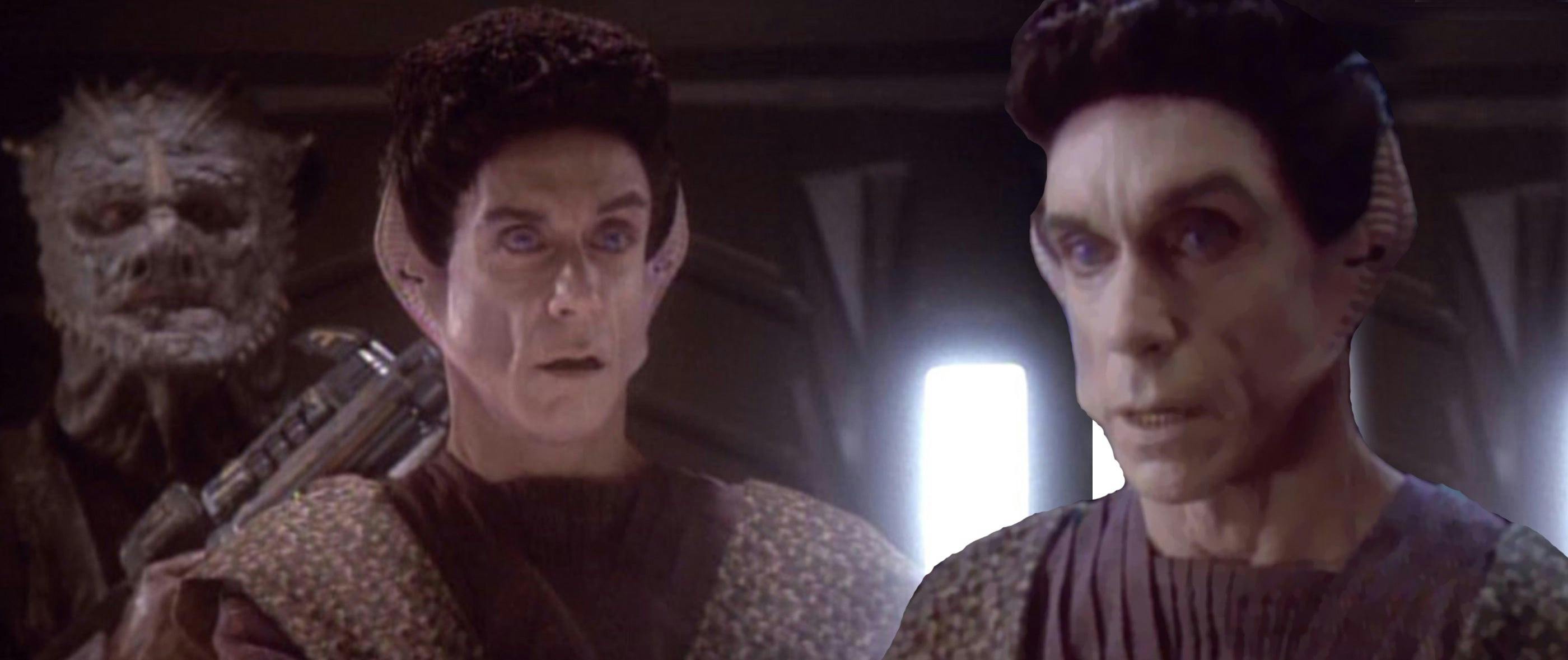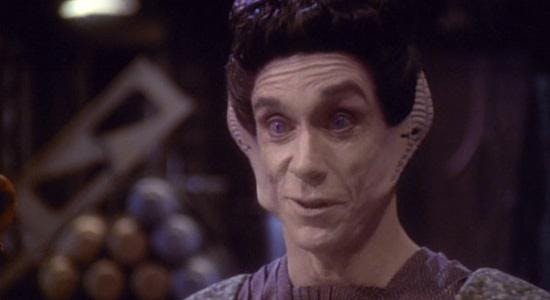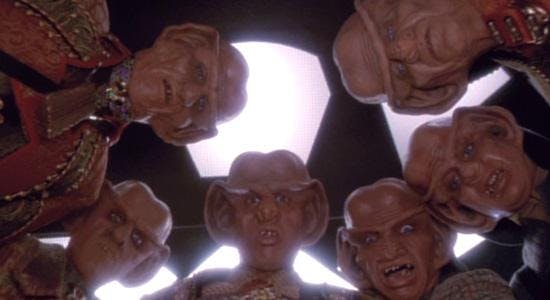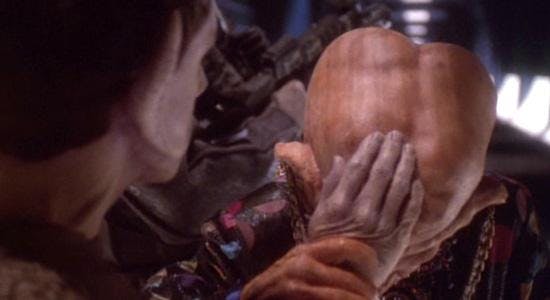Published Apr 20, 2018
That Time Iggy Pop Played a Vorta
That Time Iggy Pop Played a Vorta

Boldly going where no one has gone before. It's been in the mission statement since the beginning, first uttered by Zefram Cochrane and adhered to by every writer and producer to work on the Star Trek franchise. Of all the strange new worlds our valiant space explorers have visited, one could argue that among the strangest was when Quark, Rom, Nog (ex-)Liquidator Brunt, cousin Galia and Leck the Eliminator went to Empok Nor to trade a captured Vorta for Moogie. Because that's when Iggy Pop showed up.

This week is James Newell Osterberg, Jr.'s 71st birthday, and if you don't know much about the guy, you may not realize how terrific it is that he donned the Vortan grey skin and ridged ears of a middle-management Dominion stooge named Yelgrun. Here's the backstory.
The Michigan native was living in Chicago in the 1960s when he fell in with the burgeoning garage-rock/psychedelic blues bands that were cropping up. (If you don't know what this music sounds like, drop everything and get a copy of the CD collection called “Nuggets: Original Artyfacts from the First Psychedelic Era, 1965-1968.”) He was galvanized by seeing a performance by The Doors, and particularly taken with Jim Morrison's stage persona.
Taking a daring and energetic approach to leading a rock band, as well as the moniker Iggy Pop (one of his earliest bands had been The Iguana), he formed the band The Stooges. They were not a huge success, but they were incredibly influential in crafting a new proto-punk sound that was heavy, fast and angry, but still fun. Their third album, Raw Power, produced by friend and supporter David Bowie, is a landmark piece of dirty, aggressive rock.
The Stooges' live shows, however, are where Iggy made his reputation as someone who was. . . dangerous. It may be hard for young people to understand today, but way back when rock fans had far fewer avenues to get to “know” the stars. There were no videos, no Twitter, no YouTube. A band's reputation was made by urban legend, word of mouth and extremely rare (and highly stage-crafted) TV appearances.
Stories abounded of Iggy being a maniac. He would leap off the stage into the arms of his fans. He would roll around on cut glass. He would vomit on stage. Or would he? Where facts end and where myth begins have now faded into the mists of pop culture history.
In the next phase of his career he retreated again with David Bowie to Berlin to record, among other things, the masterpiece album Lust For Life. Even if you don't think you know some of these songs, you do. The title track and “The Passenger” have been used in many TV commercials, which some might consider “selling out,” while others consider a sly example of “stickin' it to the man.” Trivia fanatics love to point out that the rhythm section, Hunt and Tony Sales, are the sons of the legendary NYC broadcaster and borscht belt comic Soupy Sales.

As the 1980s came, Iggy recorded some more “New Wave” style albums, made hilarious TV appearances (check out YouTube for his couch-chatting skills on the early David Letterman show) and started appearing in small roles in oddball films. This all culminated in 1997 with DS9's “The Magnificent Ferengi.”
By season six of DS9, the Dominion War was raging in full force and a dark tone was evident in many of the episodes. Still, a little levity is always welcome and you could always count on a Quark-centric episode for it. While Quark and Ferengi culture had already been established as something far deeper than a one-note gag (part of what makes DS9 so rich) there's no way to hold back the comedy when you get Armin Shimerman, Max Grodenchik, Jeffrey Combs and the others in their lobes.

For reasons that are a little vague, the Grand Nagus dispatches Quark to rescue Ishka (Quark and Rom's mother, also the Nagus' lover) from the clutches of the Dominion. The first half of the episode shows our heroes “teaming up” in a manner similar to the film The Magnificent Seven. However, Ferengi, by and large, are not warriors, they are negotiators! Our Magnificent Ferengi fight back the way they know how – by using their noggins.
They enter into a prisoner exchange, using a spare captured Vorta that Sisko has hangin' around. The gang heads to Empok Nor – the decrepit former Cardassian space station. (Question for the scientists reading – just because it is abandoned, why would it be keeled over in the gravity-free environment of space? Looks cool, but kinda makes no sense. . .) The Dominion strongman sent to make the exchange? None other than the subversive, dangerous punk rocker Iggy Pop.
With his deep voice and flatly midwestern accent, Iggy is one of the funniest bad guys in all of Trek. His comeback, “I was cloned,” when Quark shrugs about family is fantastic, as is his weary nodding along to Moogie's financial counseling.
Trek producer Ira Steven Behr originally tried to get Iggy for the season-three episode “Past Tense,” to play the not-all-there character Grady. Scheduling didn't work out, so that went to TOS alum Clint Howard. Ultimately, I think it all worked out for the best.
Iggy's Vorta Yelgrun is eventually captured by the Ferengi and taken back to DS9. But strangely, we never consider him much of a bad guy. We never see him personally harm anyone and, in a way, other than Weyoun, he's one of the finer windows into Vorta culture. He's just a guy doing a job, a little cranky, and with a deadpan sense of humor. Having a rock star on the show would have been cool enough, but Iggy Pop, the writers and producers truly made the most of it, making this one of the best bits of strange casting on the show.
Do you remember how odd it was when you first recognized Iggy Pop beneath all that makeup? And what kind of alien do you think his pal David Bowie should have played, if he ever made a trip to DS9? Let me know in the comments below.
Jordan Hoffman frequently contributes to StarTrek.com via his column, One Trek Mind, and hosted Engage: The Official Star Trek Podcast. He is also a writer, critic and lapsed filmmaker living in New York City. His work can be seen on Film.com, ScreenCrush and Badass Digest. On his BLOG, Jordan has reviewed all 727 Trek episodes and films, most of the comics and some of the novels.

